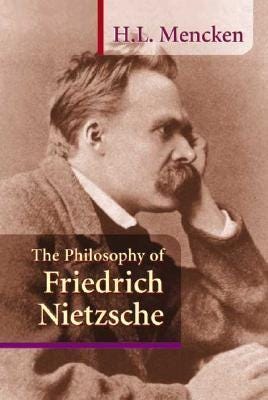America's First Dose of Nietzschean Philosophy
The Sage of Baltimore Explains the Philosopher of the Future
Mencken, H. L. The Philosophy of Friedrich Nietzsche. Tucson, AZ: See Sharp Press, 2003.
Originally published in 1908, The Philosophy of Friedrich Nietzsche demonstrates the easily recognizable wit and cunning of H. L. Mencken. Although the book is primarily a summary of the philosopher, Friedrich Nietzsche, Mencken is quick to bring his own views, tastes, and philosophical musings to bear on all that pertains to Nietzsche. Mencken was, in this way, ahead of the times in the United States. When he first sat down to pen this brief sketch, no other English work had attempted to wrestle with the difficult, and often dense, theories of the provocative German (i). Mencken clearly recognized the importance of Nietzsche's works, and he thus sought to make them accessible to every interested reader on the other side of the pond.
The book is broken into three parts: Nietzsche the Man, the Philosopher, and the Prophet. Each section has a particular angle on the writings of Nietzsche, but none of them ever lose sight of the whole picture. Despite the complexities of writing a biography and summarizing a philosophical system that was never formalized by its inventor, Mencken accomplishes this very task. In Part 1, Mencken weaves biographical snippets with quotes and paraphrases from Nietzsche’s writing in such a way, that the reader comes to see how easily his life formed his philosophy and vice versa. From the earliest days of rebellion against his family’s line of clergy to his college exposures to the great minds of the time, every moment plays a pivotal role in the development of those grand ideas still germinating in Nietzsche’s mind (2-4, 11-12). But Nietzsche's destiny did not lie in mere regurgitation; he “harbored a fevered yearning to call all of these false prophets to book and to reduce their fine axioms to absurdity,” a labor in which Mencken believes Nietzsche was successful (17).
Part 2 marks the direct examination of Nietzsche’s philosophy, though Mencken’s approach is less-than-direct. While it might be expected to work through the published thoughts of Nietzsche, taking a chronological approach, Mencken concentrates on the main ideas of Nietzsche’s work. This leads him to deal with the Dionysian phase of Nietzsche’s work first, but to handle all his later developments at this juncture too (41-42). In this fashion, Mencken works through each phase of Nietzsche’s philosophy, and consistently draws back upon earlier ideas and concepts to present everything as a unified whole. The final two chapters of this section offer brief snippets of minor themes in Nietzsche's work, as well as a brief commentary on the tumultuous relationship between Nietzsche and Richard Wagner. In Mencken’s view, it was the end of Nietzsche’s friendship with Wagner which precipitated his rejection by the same men who had claimed to follow him into his Dionysian trance (150).
Part 3 offers two short chapters which chronicle where Nietzsche fits in the development of Western philosophy, and the way he was treated by his critics. Though engaging, both chapters offer little insights into the actual philosophy of Nietzsche and tend to favor Mencken’s own penchant for a quick witty retort.
For Mencken, the most difficult aspect of Nietzsche’s philosophy is the moments wherein the German philosopher seems to default back towards a supernatural explanation of things (85-86). Mencken presents a view of Nietzsche that is catered to his own tastes and spends little time seriously wrestling with the incongruities of his German idol’s thoughts or life. When Nietzsche holds to the idea of eternal recurrence, Mencken simply asserts that Nietzsche eventually accepted that such an idea could not withstand the empirical test and moves on (69-70). And when Nietzsche’s own views do not go far enough, such as relating to Christianity or Education, Mencken inserts his own perspective in a curious manner wherein it becomes difficult to tell exactly who is doing the thinking (cf. 77-78, 129-130). It is also interesting to see how Mencken fits into the scheme of his own day, sometimes siding with Bernard Shaw and other times with Max Nordau, never highlighting that such men saw themselves as opponents.1
The See Sharp Press reprint, edited by Charles Bufe, includes minor editorial footnotes, and a brief introduction regarding Mencken’s life and works (i-xii). The value of these notes is up for debate, as the editor highlights areas of Mencken’s philosophy which he finds problematic, while leaving to stand positions which would create the same tensions for others of Mencken’s readers. For instance, compare the editor’s rebuttal of Mencken’s prejudices of class (xi) with his unsubstantiated claims about how there are no actual Christians in the world (75, 84). In addition, the book sections have been eliminated. While the publisher explains that this is for clarity, it removes the emphasis that Mencken seemed to intend in the original publication.2 While it is certainly no surprise that an editor would agree with an author they are working with, it seems odd to accuse a philosopher of making unprovable claims in spot, only to ignore the same kind of thing in another.
Overall, Mencken is clever and the epitome of brevity. He is at his best when expounding an idea of Nietzsche's while simultaneously highlighting its weaknesses. As a result, Mencken’s work is the most succinct, and accurate, introduction to the work of Friedrich Nietzsche around.
Cf. Bernard Shaw, “Echolalia,” The Sanity of Art (New York: Benj. R. Tucker, 1908), 81-108, for Shaw’s arguments against Nordau, particularly in his assessment of Wagner.
This is only one issue among many. There are numerous errata in the text (i.e. page xi, ln. 17 “that” which should be “than”), as well as the omission of the 1908 introduction, which is considerably more informative than the third edition version retained here. Even the epigraph from Schopenhauer is gone, which Mencken undoubtedly selected intentionally.





